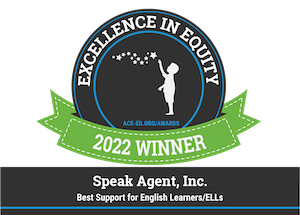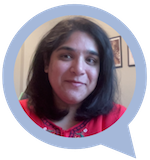The Language of Content
Articles from Speak Agent with math literacy and science resources, strategies, research, and program updates.
Building Classroom Community Through Content and Storytelling
August 18, 2022 | Divya Shannon |
-
- "Getting to know your students..." It sounds so easy: ice breakers, getting-to-know-you games, and other similar tools are at your fingertips. But which ones will be the most effective? What will be new and exciting for your students? Which ones will lead seamlessly into what you have to do next?
- "Getting to know your students..." It sounds so easy: ice breakers, getting-to-know-you games, and other similar tools are at your fingertips. But which ones will be the most effective? What will be new and exciting for your students? Which ones will lead seamlessly into what you have to do next?
Research shows that the teacher-student relationship is the cornerstone of building a good classroom culture. A constructive relationship facilitates learning for all students. It’s not only equitable; it’s smart. If you know your students, you can motivate them. And, if you can motivate and encourage them, learning with you becomes something they look forward to and enjoy. Engaged students display better classroom behaviors and help to build a collaborative classroom that supports all learners.
DISCUSS and LISTEN: .png?width=352&name=Speak%20Agent%20Templates%20(1090%20%C3%97%201080%20px).png) Strong connections start with storytelling. How are you doing? What did you do over summer break? What interests you about this class? These are all stories our students tell us that give us insight into who they are and what drives them. This simple but engaging activity creates connections with and among students and facilitates discussions centered on themselves and the curriculum content. Story sharing is most effective when it’s authentic and relevant, and the students feel like they are represented.
Strong connections start with storytelling. How are you doing? What did you do over summer break? What interests you about this class? These are all stories our students tell us that give us insight into who they are and what drives them. This simple but engaging activity creates connections with and among students and facilitates discussions centered on themselves and the curriculum content. Story sharing is most effective when it’s authentic and relevant, and the students feel like they are represented.
Taking the time to talk and listen is critical in establishing a connection with your students early on. Get your students engaged early by carving out ample one-on-one time. As an educator, this was always the most challenging part for me — finding a meaningful activity for the students and setting behavioral and academic expectations, all while allowing myself the time to spend with them individually and building our classroom community. Seek out programs that include story-based elements and a streamlined structure for students to work independently and get immediate feedback. The discussion and engagement will happen organically. Then, you can spend your energy on the kids and not on the prep or management!
EARLY SUCCESS: A powerful story or discussion also requires students to communicate with one another, which doesn’t come easily to all. In math and science, all students are learning the academic language for the first time. You also work with your multilingual learners who are learning conversational English at the same time. My most successful classrooms have been when students gain confidence in their skills early on, especially in their ability to ask and answer questions.
Have you had team members or even administrators tell you that community building should be your focus for the first few weeks? They are not wrong, but prioritizing community building doesn’t mean you have to forgo content. That tussle between the two never made sense to me.
.png?width=454&name=Twitter%20Post%20Templates%20(8).png) As soon as I could, I’d get the students playing with math, collaborating, and growing their academic language. I specifically say “playing” because it does have to be a new and unusual approach to math that hooks them. Remember, your first few lessons set the tone and expectations for your class. Look for resources that emphasize math applications. Focus on the basic prerequisite skills for your class. For example, if students need to do a lot of algebraic manipulation in your course, look for activities that help them build their number sense and estimation skills.
As soon as I could, I’d get the students playing with math, collaborating, and growing their academic language. I specifically say “playing” because it does have to be a new and unusual approach to math that hooks them. Remember, your first few lessons set the tone and expectations for your class. Look for resources that emphasize math applications. Focus on the basic prerequisite skills for your class. For example, if students need to do a lot of algebraic manipulation in your course, look for activities that help them build their number sense and estimation skills.
.png?width=571&name=Twitter%20Post%20Templates%20(9).png)
.gif?width=331&name=Speak%20Agent%20Templates%20(1090%20%C3%97%201080%20px).gif)
DIFFERENT LENSES: Talking with students takes most of your time and energy during class. But the connection-building doesn’t have to stop there. All students are multifaceted and they may have hidden strengths or struggles that you don’t see right off the bat.
I cannot overemphasize the power of data, but it can be difficult to collect if you don’t have the right tools. Get to know your students in different ways through shared experiences, listening to their conversations, and data collection. Many programs available let you collect data on your student's understanding and progress,
so choose one that meets your particular needs.
It’s also important to know how you are analyzing your data. Do you want to identify students for targeted intervention? Then pick a resource that gives you a summary of their progress at the end of each lesson. Do you want to plan your group work or differentiation based on what you see? Focus on activities that easily give you individual and class information. Are you looking at student work to have things to talk to them about the next time you see them? Use programs that build a portfolio of student work for you. Use technology to identify the patterns, so you can spend time getting to know the eager learners joining your classroom this year!
There are so many ways to build a strong community in your classroom. If any of these ideas in this article appeal to you, but you need help visualizing them for your classroom, don’t hesitate to reach out!

2022 – Category Winner of Excellence in Equity: Best Support for English Learners
Additional Resources
- Language Strategies Benefit All Students
- Using Speak Agent In Your Classroom
- Reducing Teacher Burnout Through Curriculum Mapping
- Podcast: The Equity Impact of Understanding Academic Language (01/29/2023)
- Podcast: Phenomenal Spotlight: What Is Speak Agent? (Part 1) (09/10/2022)
- Equity+Speak Agent Overview Document
Read Also
- ClassTech Tips Blog: How to Learn Math and Science with Language Support
- eSchool News: How a Major MD District Boosted Middle Math Achievement
- Digital Promise: Integrating Research-based Strategies into the Design of Educational Technology to Support All Learners

Written by Divya Shannon
Divya is Speak Agent's secondary STEM specialist with 11 years of experience teaching all levels of high school math, biology, physics, and chemistry.

